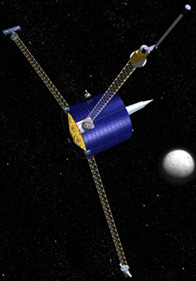|
NASA's Lunar Prospector was a 660-lb. spacecraft that orbited the Moon at an altitude of 63 miles from where it spotted evidence of ice in shaded regions of the lunar poles. Lunar Prospector is over the Moon in the NASA artist rendering above.When NASA launched Lunar Prospector from Earth on January 6, 1998, it was the first time in 25 years the space agency had flown a research spacecraft to Earth's natural satellite. Launch and cruise. After blast off on a Lockheed Martin Athena II rocket from Spaceport Florida's pad 46 — part of a new commercial launch complex at Cape Canaveral, Florida — Lunar Prospector cruised for 110 hours to the Moon where it was inserted into its circular, polar orbit. It was the third launch in NASA's Discovery program of low-cost highly-focused planetary science missions. In orbit. In its search for water ice, Lunar Prospector did not land on the surface. Instead, it traveled around the Moon — from pole to pole — 62 miles above the surface. Each orbit takes 118 minutes — about two hours. After a year, Lunar Prospector flew at altitudes as low as six miles above the lunar surface. The spacecraft. Lunar Prospector was shorter than five feet tall and controlled remotely from Earth. It was a graphite epoxy drum, 4.5 ft. in diameter and 4 ft. high with three eight-foot-long instrument booms. Five instruments attached to those boom arms looked for signs of iron, aluminum, uranium and calcium on the surface. Lunar Prospector was spin-stabilized and controlled by six hydrazine monopropellant 22-Newton thrusters.  For electrical power, the probe had 202 watts of solar cells storing energy in a set of 15-ampere-hour NiH batteries. Oddly, there was no computer aboard Lunar Prospector. Ground command was through a 3.6 kbps telemetry link using two S-band transponders and a slotted, phased-array medium gain antenna and omnidirectional low-gain antenna.
For electrical power, the probe had 202 watts of solar cells storing energy in a set of 15-ampere-hour NiH batteries. Oddly, there was no computer aboard Lunar Prospector. Ground command was through a 3.6 kbps telemetry link using two S-band transponders and a slotted, phased-array medium gain antenna and omnidirectional low-gain antenna.
Mapping the surface. Data from the one-to-three-year mission allowed construction of a detailed map of the surface composition of the Moon, and improved our understanding of the origin, evolution, current state, and resources of the Moon. Lunar Prospector mapped the surface composition, measured magnetic and gravity fields, studied lunar outgassing events, and prospected for minerals. The information will help humans can go back to the Moon to build a base and learn to live off the land. Data from Lunar Prospector will tell those pioneers where to get the necessary resources. Water ice. The first data returned by Lunar Prospector answered a question raised in the 1970s and again in 1994 by the Clementine mission. Is there water held as ice in some polar craters? Because previous missions spotted evidence of hydrogen in the polar regions of the Moon, suggesting traces of water, a neutron spectrometer aboard the spacecraft looked for hydrogen. Water ice found >> Instruments also looked for signs of gases spewing from the interior of the Moon and measured the lunar magnetic field. Scientists looked for similarities between Earth and the Moon. They had a theory that an asteroid slammed into Earth billions of years ago, shooting debris into space which clumped together to form the Moon. By mapping the surface of the Moon, they learned about the bulk composition of the Moon, which allowed them to compare it to the bulk composition of the Earth. Earlier Moon probes. In 1990, Japan sent its Muses-A robot science explorer into an Earth-Moon orbit. Later renamed Hiten, the unmanned explorer dropped a miniature satellite called Hagoromo into lunar orbit as Hiten swung around the Moon. Now, Japan is planning additional Moon research with a more sophisticated orbiter with lander. Japan's first Moon flight >> Earlier lunar spacecraft: |